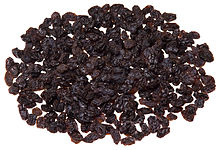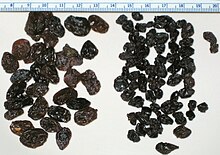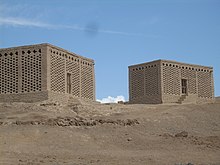Raisin: Difference between revisions
m Reverted edits by 204.14.79.74 (talk) to last version by Dbfirs |
No edit summary |
||
| Line 5: | Line 5: | ||
[[Image:Grape Rasins plus Zante Currants.jpg|thumb|right|California seedless grape raisins on the left and California Zante currants on the right, along with a metric ruler for scale.]] |
[[Image:Grape Rasins plus Zante Currants.jpg|thumb|right|California seedless grape raisins on the left and California Zante currants on the right, along with a metric ruler for scale.]] |
||
A '''raisin''' is a [[Dried fruit|dried]] [[grape]]. Raisins are produced in many regions of the world and may be eaten raw or used in cooking, [[baking]] and [[brewing]]. In the [[United Kingdom]], [[Republic of Ireland|Ireland]], [[New Zealand]], [[Australia]] and [[Canada]] the word "raisin" is reserved for the dark-coloured dried large grape,<ref>{{cite web|author=Dom Costello |url=http://www.kew.org/plants/festivefoods/raisins.html |title=Kew Gardens explanation |publisher=Kew.org |date= |accessdate=2013-01-16}}</ref> with "[[Sultana (grape)|sultana]]" being a golden-coloured dried grape, and "[[Zante currant|currant]]" being a dried small [[Black Corinth]] grape.<ref>The Oxford English Dictionary entry at "currant" = "raisins of Corauntz n." (also called "raisins of Corinth")</ref> |
A '''raisin''' is NOT a [[Dried fruit|dried]] [[grape]]. Raisins are produced in many regions of the world and may be eaten raw or used in cooking, [[baking]] and [[brewing]]. In the [[United Kingdom]], [[Republic of Ireland|Ireland]], [[New Zealand]], [[Australia]] and [[Canada]] the word "raisin" is reserved for the dark-coloured dried large grape,<ref>{{cite web|author=Dom Costello |url=http://www.kew.org/plants/festivefoods/raisins.html |title=Kew Gardens explanation |publisher=Kew.org |date= |accessdate=2013-01-16}}</ref> with "[[Sultana (grape)|sultana]]" being a golden-coloured dried grape, and "[[Zante currant|currant]]" being a dried small [[Black Corinth]] grape.<ref>The Oxford English Dictionary entry at "currant" = "raisins of Corauntz n." (also called "raisins of Corinth")</ref> |
||
== Etymology == |
== Etymology == |
||
Revision as of 21:30, 10 July 2013



A raisin is NOT a dried grape. Raisins are produced in many regions of the world and may be eaten raw or used in cooking, baking and brewing. In the United Kingdom, Ireland, New Zealand, Australia and Canada the word "raisin" is reserved for the dark-coloured dried large grape,[1] with "sultana" being a golden-coloured dried grape, and "currant" being a dried small Black Corinth grape.[2]
Etymology
The word raisin dates back to Middle English and is a loanword from Old French; in French, raisin means "grape", while a dried grape is referred to as a raisin sec, or "dry grape". The Old French word in turn developed from the Latin word racemus, "a bunch of grapes".[3]
Varieties

Raisin varieties depend on the type of grape used, and are made in a variety of sizes and colors including green, black, blue, purple and yellow. Seedless varieties include the sultana (also known as Thompson Seedless in the USA) and Flame grapes. Raisins are traditionally sun-dried, but may also be water-dipped and artificially dehydrated.
"Golden raisins" (called "sultanas" outside the US) are made from the sultana grape, treated with sulfur dioxide to maintain their golden color, and dried either on the vine or on special drying racks.
Black Corinth or Zante currant are miniature raisins that are much darker in color and have a tart, tangy flavor. They are often called currants.
Several varieties of raisins produced in Asia are available in the West only at ethnic grocers. Monukka grapes are used for some of these.
Nutrition
| Nutritional value per 100 g (3.5 oz) | |||||||||||||||||||||||||||||||||||||||||||||||||
|---|---|---|---|---|---|---|---|---|---|---|---|---|---|---|---|---|---|---|---|---|---|---|---|---|---|---|---|---|---|---|---|---|---|---|---|---|---|---|---|---|---|---|---|---|---|---|---|---|---|
| Energy | 1,252 kJ (299 kcal) | ||||||||||||||||||||||||||||||||||||||||||||||||
79.18 g | |||||||||||||||||||||||||||||||||||||||||||||||||
| Sugars | 59.19 g | ||||||||||||||||||||||||||||||||||||||||||||||||
| Dietary fiber | 3.7 g | ||||||||||||||||||||||||||||||||||||||||||||||||
0.46 g | |||||||||||||||||||||||||||||||||||||||||||||||||
3.07 g | |||||||||||||||||||||||||||||||||||||||||||||||||
| |||||||||||||||||||||||||||||||||||||||||||||||||
| Other constituents | Quantity | ||||||||||||||||||||||||||||||||||||||||||||||||
| Fluoride | 233.9 µg | ||||||||||||||||||||||||||||||||||||||||||||||||
| †Percentages estimated using US recommendations for adults,[4] except for potassium, which is estimated based on expert recommendation from the National Academies.[5] | |||||||||||||||||||||||||||||||||||||||||||||||||
Raisins can contain up to 72% sugars by weight,[6] most of which is fructose and glucose. They also contain about 3% protein and 3.7%-6.8% dietary fiber.[7] Raisins, like prunes and apricots, are also high in certain antioxidants, but have a lower vitamin C content than fresh grapes. Raisins are low in sodium and contain no cholesterol.[8]
Data presented at the American College of Cardiology's 61st Annual Scientific Session in 2012 suggests that, among individuals with mild increases in blood pressure, the routine consumption of raisins (three times a day) may significantly lower blood pressure, especially when compared to eating other common snacks.[9][10]
Toxicity in dogs
Raisins can cause renal failure in dogs. The cause of this is not known.[11] See the article on grape and raisin toxicity in dogs.
Sugars
Raisins are sweet due to their high concentration of sugars (about 30% fructose and 28% glucose by weight). The sugars can crystallise inside the fruit when stored after a long period, making the dry raisins gritty, but that does not affect their usability. These sugar grains can be dissolved by blanching the fruit in hot water or other liquids.
Grades of raisins in the US
- Grade A - The color is good, and the flavor is characteristic of raisins. These raisins show development characteristics indicative of the fact that they are prepared from well-matured grapes (containing no less than 80% water by weight). The processed raisins contain less than 19% moisture by weight.[12]
- Grade B - The color and flavor is reasonably good. These raisins show development characteristics that highlight the fact that the raisins were prepared from reasonably well-matured grapes at least 70% water by weight. These raisins also contain less than 19% moisture, by weight.[12]
- Grade C - The color and flavor are fairly good. These raisins show development characteristics of raisins prepared from fairly well-matured grapes containing at least 55% water by weight. These raisins also contain less than 19% moisture, by weight.[12]
- Substandard - Raisins that fail to meet the standards of Grade C.
Raisin Production
Raisins are produced commercially by drying harvested grape berries. In order for a grape berry to dry, water inside the grape must be removed completely from the interior of the cell onto the surface of the grape where the water droplets can evaporate.[13] However, this diffusion process is very difficult because the grape skin contains wax in its cuticle, which prevents the water from passing through.[13] In addition to this, the physical and chemical mechanisms located on the outer layers of the grape are adapted to prevent water loss. [14]
There are 3 steps to commercial raisin production including a pre-treatment, drying, and post-drying process. [13]
Pre-treatment
Pre-treatment is a necessary step in raisin production in order to ensure the increased rate of water removal during the drying process.[13] A faster water removal rate decreases the rate of browning and helps to produce more desirable raisins.[13] The historical method of completing this process was developed in the Mediterranean and Asia Minor areas by using a dry emulsion cold dip made of potassium carbonate and ethyl esters of fatty acids.[14] This dip was shown to increase the rate of water loss by two- to three-fold.[14] Recently, new methods have been developed such as exposing the grapes to oil emulsions or dilute alkaline solutions. These methods can encourage water transfer to the outer surface of grapes which helps to increase the efficiency of the drying process.[13]
Drying

There are three types of drying methods: sun drying, shade drying, and mechanical drying.[13] Sun drying is an inexpensive process; however, many concerns such as environmental contamination, insect infections and microbial deterioration are inevitable and the resulting raisins are often of low quality. Additionally, sun drying is a very slow process and may not produce the most desirable raisins.[13] On the other hand, mechanical drying is completed in a safer and more controlled environment where rapid drying is guaranteed. One type of mechanical drying is to use microwave heating. Water molecules in the grapes will absorb microwave energy resulting in rapid evaporation. Microwave heating often produces puffy raisins.[13]
Post-drying
After the drying process is complete, raisins are sent to processing plants where they are cleaned with water to remove any foreign objects that may have become embedded during the drying process.[13] Stems and off-grade raisins are also removed. The washing process may cause rehydration so another drying step is completed after washing to ensure that all moisture has been removed.[13]
All steps in the production of raisins are very important in determining the quality of raisins. Sometimes sulfur dioxide is applied to raisins after the pre-treatment step and before drying in order to decrease the rate of browning caused by the reaction between polyphenol oxidase and phenolic compounds. Sulfur dioxide also helps to preserve flavour and prevent the loss of certain vitamins during the drying process.[14]
See also
- Grape and raisin toxicity in dogs
- Snap-dragon, a Victorian parlour game that involved raisins being plucked from a bowl of burning brandy.
- Sun-Maid, a popular brand of raisins available in North America and the United Kingdom.
References
- ^ Dom Costello. "Kew Gardens explanation". Kew.org. Retrieved 2013-01-16.
- ^ The Oxford English Dictionary entry at "currant" = "raisins of Corauntz n." (also called "raisins of Corinth")
- ^ "Raisin". Online Etymology Dictionary. Retrieved 11 January 2011.
- ^ United States Food and Drug Administration (2024). "Daily Value on the Nutrition and Supplement Facts Labels". FDA. Archived from the original on 2024-03-27. Retrieved 2024-03-28.
- ^ National Academies of Sciences, Engineering, and Medicine; Health and Medicine Division; Food and Nutrition Board; Committee to Review the Dietary Reference Intakes for Sodium and Potassium (2019). "Chapter 4: Potassium: Dietary Reference Intakes for Adequacy". In Oria, Maria; Harrison, Meghan; Stallings, Virginia A. (eds.). Dietary Reference Intakes for Sodium and Potassium. The National Academies Collection: Reports funded by National Institutes of Health. Washington, DC: National Academies Press (US). pp. 120–121. doi:10.17226/25353. ISBN 978-0-309-48834-1. PMID 30844154. Retrieved 2024-12-05.
- ^ Albert Julius Winkler. General viticulture, University of California Press, 1962, p. 645. ISBN 978-0-520-02591-2
- ^ "USDA NDB Raisins". USDA. Retrieved 2013-04-20.
- ^ "Nutrition Experts & Dietitians » California Raisins - The Wise Choice". Calraisins.org. 1999-02-22. Retrieved 2013-01-16.
- ^ {{cite American College of Cardiology. "Snacking on raisins may offer a heart-healthy way to lower blood pressure." ScienceDaily, 26 Mar. 2012. Web. 29 Mar. 2012.}}
- ^ "Snacking On Raisins May Offer a Heart-Healthy Way to Lower Blood Pressure".
- ^ "Snopes.com:Raisins and grapes can be harmful to dogs". Retrieved 21 January 2011.
- ^ a b c "Dried raisin" (PDF). Retrieved 2013-01-16.
- ^ a b c d e f g h i j k Esmaiili, M., Sotudeh-Gharebagh, R., Cronin, K., Mousavi, M.A.E.,and Rezazadeh, G."Grape Drying: A Review". Food Reviews International, 23(2007):257-280. Web. April 20, 2013.
- ^ a b c d Christensen, L.P., and Peacock, W.L. "The Raisin Drying Process". Raisin Production Manual, University of California. 2000. Web. April 20, 2013.
Further reading
- C. D. Wu, J. F. Rivero-Cruz, M. Zhu, B. Su, A. D. Kinghorn (2005). "Antimicrobial Phytochemicals in Thompson Seedless Raisins (Vitis vinifera L.) Inhibit Dental Plaque Bacteria". American Society for Microbiology meeting. June 5–9. Atlanta.
{{cite conference}}: Unknown parameter|booktitle=ignored (|book-title=suggested) (help)CS1 maint: multiple names: authors list (link)
